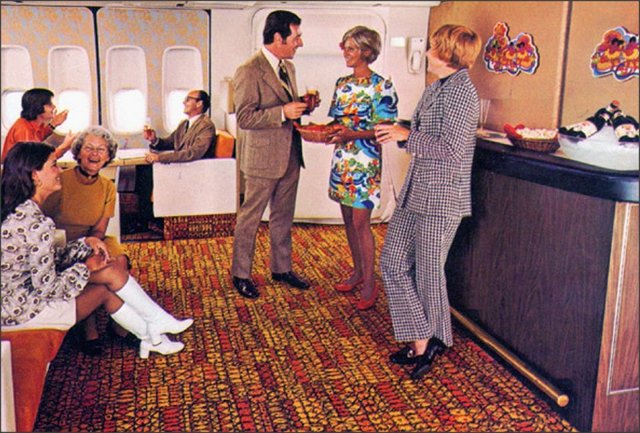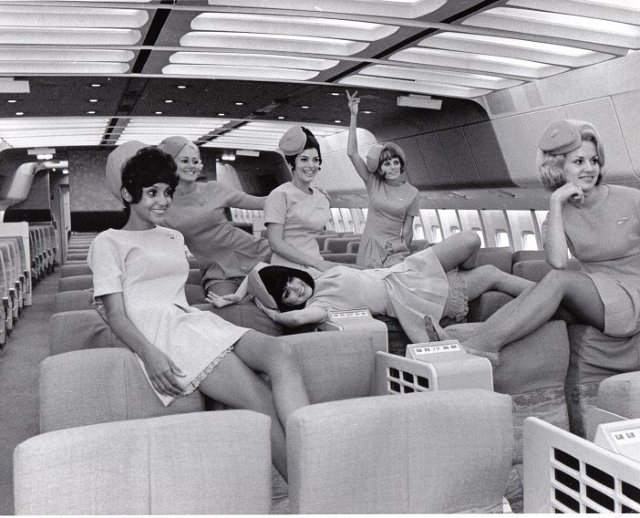When we think about the Golden Age of Flying--the glory years of Pan Am and the Concorde in the 1950s and 1960s, before flight became cheap with the rise of the jumbo jet--we imagine a colorful, lavish era in which our every comfort and requirement is catered to. Gone are the inconveniences and annoyances of modern travel: the cramped seats, the dismissive stewardesses, the long security lines, and so on. Instead, we think of a vintage airline brochure come to life.
But was it really so great to fly 50 years ago? To find out, we asked Guillaume de Syon, a professor at Pennsylvania's Albright College and an expert on aviation history. Although there were many benefits of flying in the 1950s and 1960s, de Syon says, the reality was far different than you might expect. In fact, once you know what flying during the so-called Golden Age was really like, you might prefer a jaunt on easyJet.
Very expensive
The first major distinction between the Golden Age of Flying and flying today was that it was significantly more expensive.

In the 21st century, air travel is relatively cheap, but in the 1950s, you could expect to pay 40% or more for the same ticket you buy today. A ticket on TWA in 1955 from Chicago to Phoenix, for example, cost $138 round-trip. Adjusted for inflation, that's $1,168. But that doesn't tell the whole story, because the average salary in the United States is higher than it was in the 1950s. That round-trip ticket between Chicago and Phoenix would cost the average person today a little more than 1% of his yearly income to purchase. Comparatively, the average person in the 1950s would pay up to 5% of his yearly salary for a chance to fly.
"Varying on the route, it was four to five times as expensive to fly in the Golden Age," de Syon says. "If you were a secretary, it might cost you a month's salary to take even a short flight."
Scary and dangerous
So what did you get for paying five times as much for your plane ticket? A five times greater chance of being killed compared with jumping on a flight today.
"Statistically, there were a lot more plane crashes and flight accidents in the Golden Age of Flying," de Syon says.

These days, when you board a plane, you have a very good chance of landing safely on the other side. In fact, for every 100,000 hours that planes are in the air, there are only 1.33 fatalities. That makes flying one of the safest way to travel now, but in 1952, that number was 5.2 deaths per 100,000 hours, and this despite the fact that the number of passengers flying on American carriers has increased 42 times in the last 60 years. Less sophisticated flying technology was mostly to blame. "It wasn't safe to land in fog, so there were many crashes. Mid-air collisions were common," explains de Syon. "Engines dropped out of planes so often that they weren't even recorded as accidents if the other engine could land them safely."
You didn't just have to worry about crashing, though. Let's imagine a typical flight incident, where an airplane hits a patch of turbulence and drops 500 hundred feet. Today, it would be unusual for such an incident to do more than give people a scare, but 60 years ago, due to lower cabin ceilings and inferior seat belt designs, that same incident could snap your neck.
There were other environmental factors that could hurt you too. In the Golden Age of Flying, there were glass dividers that separated first class from economy. These dividers looked nice, but could shatter and spray passengers during accidents or turbulence. Even walking to the bathroom in a 1950s-era aircraft could be fatal, as the plane interiors were not designed with safety in mind. Trip and you could find yourself landing on a sharp edge or jag of a chair or table. "In the 1950s, people were afraid to fly, and for good reason," de Syon says.
Boring
Once you get tired of looking out the window, flying is inherently boring: you're sealed in a droning metal tube for hours and expected to just sit there, staring at the back of the seat ahead of you, for hours. Yet today, we take for granted that we have access to a number of distractions from the monotonousness of travel. We have iPhones, iPads, Kindles, and Gameboys to distract us, and even if you forget your gadgets at home, you can watch a number of movies, or listen to music, or even play a video game on the screen in front of you, at least on most long-haul flights.
These distractions were not available in the Golden Age of Flying. In-flight movies did not become popular until the mid-1960s, and during a time when all portable music came over the radio, there wasn't even the option to plug in a pair of headphones and listen to music during your flight until 1985.
So what did people do instead? They wrote postcards.
"Back in the 1950s, you were handed postcards when you boarded a flight, which might have a picture of the plane or the meal you were going to be served printed on it," de Syon says.
The tradition at the time was that you would use your in-flight time to write people you knew on the ground, describing your flight. Once you ran out of postcards to write, there wasn't much to do. Magazines and newspapers were provided to passengers, and you could also read a book. Some airlines, like Air France, experimented with commissioning artists to create paintings to hang on the cabin walls for passengers to look at, but this didn't last long.
If you were lucky, the person sitting next to you might be a good conversationalist. Otherwise? You smoke and drank. Which brings us to our next point.
Booze-filled ashtrays
Unless you are a chain smoker, and the idea of being sealed up in an aquarium of secondhand smoke seems like a great way to spend eight hours, you'd likely find the experience of flying in the Golden Age of Flying pretty gross. You could smoke on flights and not just cigarettes: pipes and cigars were also encouraged. In fact, the only time people weren't allowed to smoke on airplanes was on the ground, because airlines were afraid that smoking might ignite refueling fumes.

That's bad enough, but there was also a lot of alcoholism at 30,000 feet back in the 1950s and 1960s. To fly back then was to be served as much free booze as you could drink, and people tended to just drink to keep themselves entertained. "Memoirs written during the Golden Age of Flying are filled with lively accounts of drunken passengers," de Syon says. "People would just pour themselves scotch after scotch." Getting hammered was just a way to past the time.
The good news is such drinking did not tend to get violent: because there were far fewer passengers, the crowding that contributes to the alcoholic air rage of today didn't really exist. But that doesn't mean that people didn't pull out all the other stops on drunken behavior, such as stumbling down the aisle, molesting stewardesses, singing loudly, and--of course--profusely vomiting.
Extremely racist
There's another unpleasant side of flight in the 1950s and 1960s that tends to be glossed over. "I think it's important to point out that in the Golden Age of Flying, only white people really flew," says de Syon. It was a racist age, and this is reflected even at 30,000 feet.
Part of the reason why so few minorities flew was simply economic. In 1950, the median income for an African-American male was just $1,471 per year. The average white male was paid nearly twice as much, and since air travel was such a luxury, few minorities could afford it.
"If you saw a black person at an airport during the Golden Age of Flying, they were almost definitely a porter, not a passenger," de Syon says.
Even if you could afford a ticket as a minority, though, there was a good chance you wouldn't be allowed into the same planes as white passengers.
"In the 1950s, some airlines would train their phone operators to try to identify the voices of African-Americans, then put them on certain flights and not others," de Syon says. "It wasn't until the late 1960s and 1970s that things started changing. It may have been the Golden Age of Flying, but it was also a very racist age."
The Good
None of this is to say that flying in the Golden Age of Flying was a totally negative experience. There were many real luxuries and comforts of flying that we have left behind today.
For one thing, airline security simply did not exist during the Golden Age of Flying. Compared to today, when airlines recommend getting to the airport three hours ahead of time to make sure you catch your flight, the recommendation of most Golden Age airlines seems positively quaint: you were guaranteed to make your flight even if you showed up just 30 minutes before.
Once onboard, the average passenger, even in economy, had plenty of legroom. In fact, business class today is spatially very similar to what economy used to be like, de Syon says. Once aboard, all service was complimentary. And because the stewardess-to-passenger ratio was so much higher back then than it is today, you could expect one to nearly instantly cater your every (non-salacious) need.

It should also be mentioned that the Golden Age of Flying was an era of sumptuous design, a time in which the flying experience--from the visual look of the cabin, to your stewardess's uniform, right down to the silverware--was imagined by some of the world's best designers.
Yet despite all of this, there are probably few who would really prefer to fly during the Golden Age of Flying. At best, it was like something out of Catch Me If You Can. At worst, flying during the Golden Age of Flying meant paying an exorbitant amount of money to lock yourself in a pneumatic tube full of smoke and vomit, where the only possible relief from the mind-numbing boredom of travel was the significantly greater prospect of your own death or dismemberment. Says de Syon: "The Golden Age of Flying was an age where very few of us could have flown, and when only slightly more of us would likely have wanted to."